Project Management: Office Relocation Plan and Analysis Report
VerifiedAdded on 2022/10/12
|25
|4454
|22
Project
AI Summary
This project management report outlines a comprehensive plan for relocating a call center, including 250 staff members, to a new business park. The project focuses on ensuring sufficient space for various teams and IT infrastructure. The report details the project context, emphasizing the need for efficient resource allocation and stakeholder awareness. It incorporates PESTLE analysis to assess external factors, a work breakdown structure (WBS) to organize tasks, and a Gantt chart for scheduling. Risk analysis identifies potential challenges like customer loss and high startup costs, with corresponding mitigation strategies. The project also includes a RACI matrix for defining roles and responsibilities and a stakeholder management strategy. Appendices provide supporting documentation such as PESTLE analysis, WBS, Gantt chart, RACI matrix, risk matrix and stakeholder management strategy.
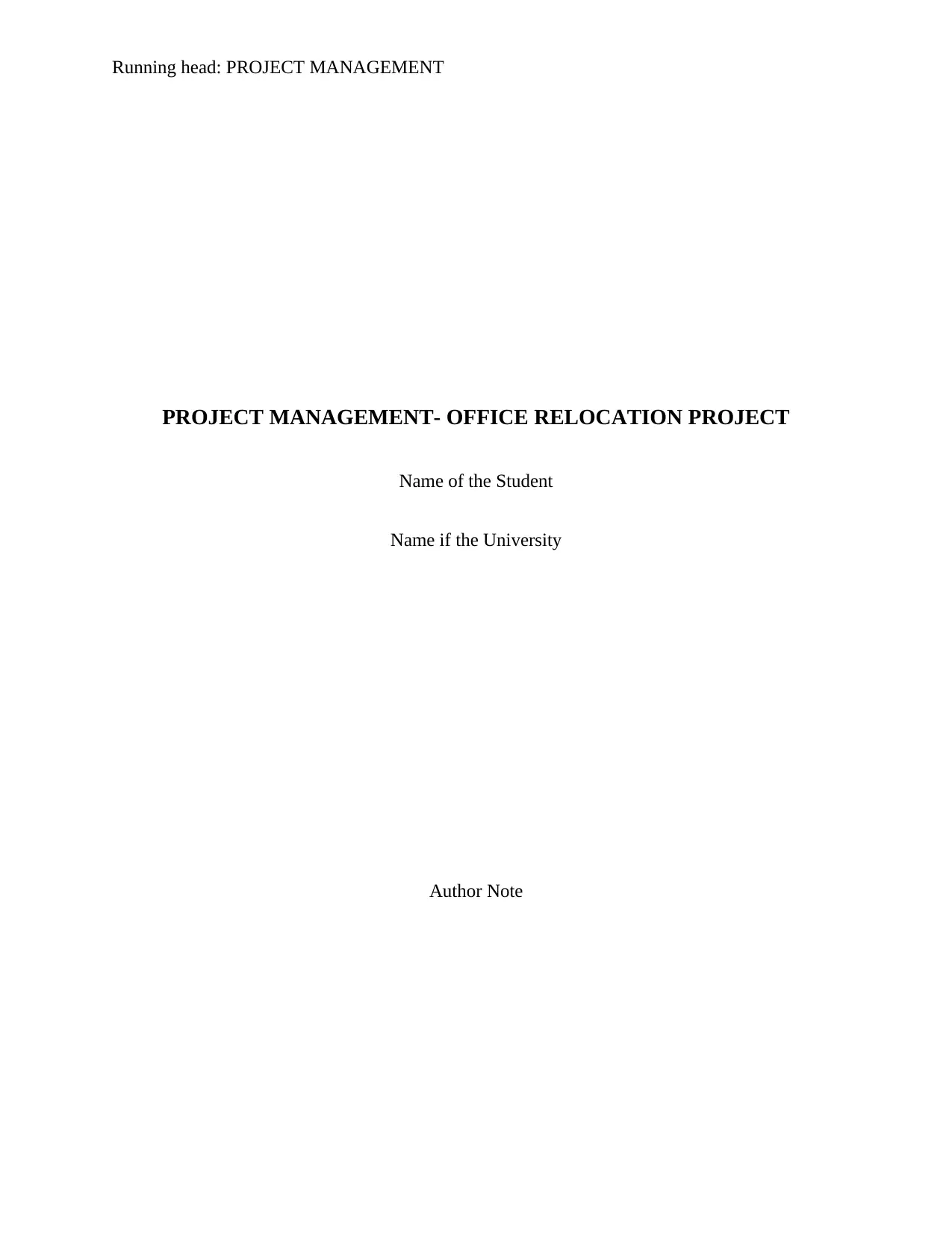
Running head: PROJECT MANAGEMENT
PROJECT MANAGEMENT- OFFICE RELOCATION PROJECT
Name of the Student
Name if the University
Author Note
PROJECT MANAGEMENT- OFFICE RELOCATION PROJECT
Name of the Student
Name if the University
Author Note
Paraphrase This Document
Need a fresh take? Get an instant paraphrase of this document with our AI Paraphraser
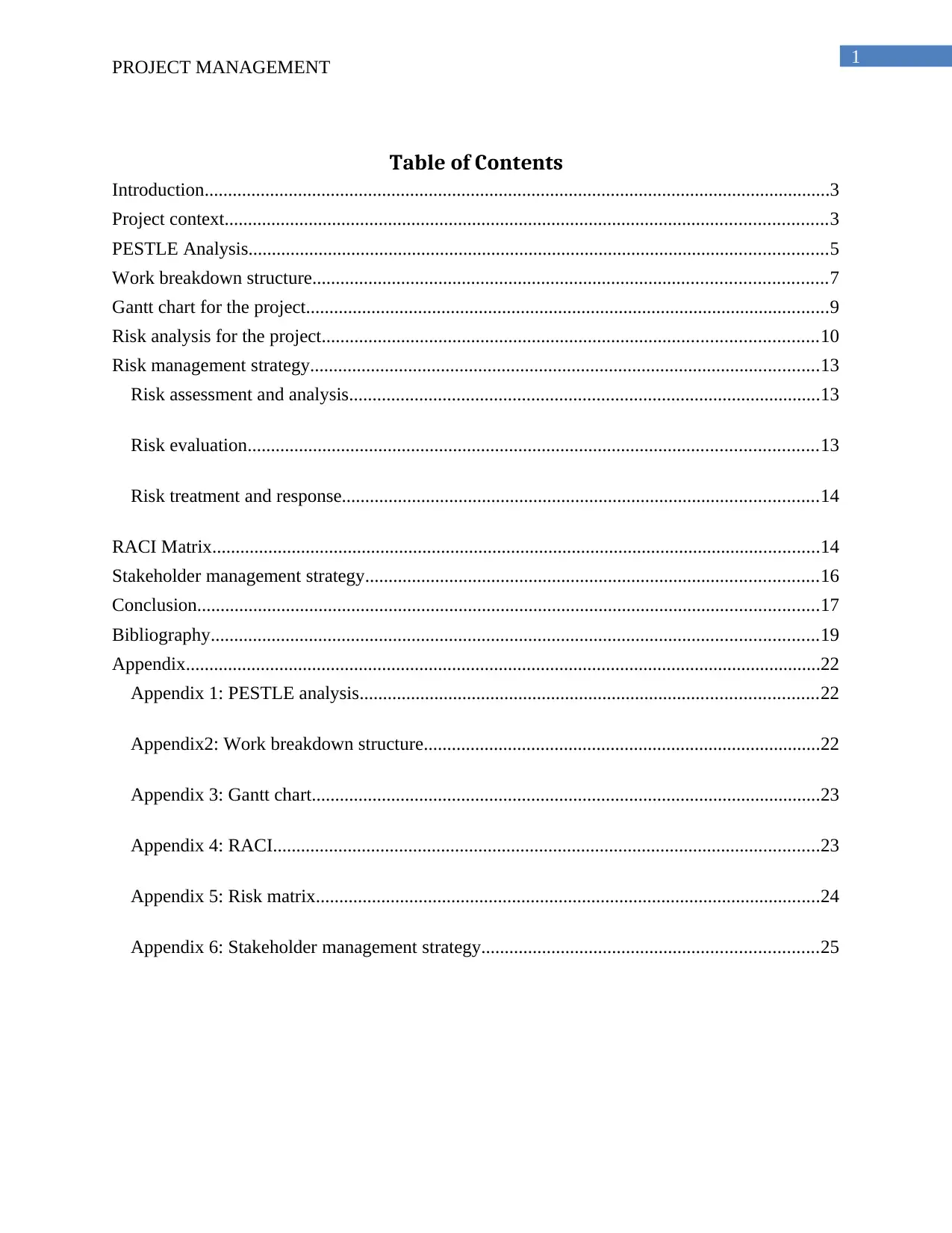
1
PROJECT MANAGEMENT
Table of Contents
Introduction......................................................................................................................................3
Project context.................................................................................................................................3
PESTLE Analysis............................................................................................................................5
Work breakdown structure..............................................................................................................7
Gantt chart for the project................................................................................................................9
Risk analysis for the project..........................................................................................................10
Risk management strategy.............................................................................................................13
Risk assessment and analysis.....................................................................................................13
Risk evaluation..........................................................................................................................13
Risk treatment and response......................................................................................................14
RACI Matrix..................................................................................................................................14
Stakeholder management strategy.................................................................................................16
Conclusion.....................................................................................................................................17
Bibliography..................................................................................................................................19
Appendix........................................................................................................................................22
Appendix 1: PESTLE analysis..................................................................................................22
Appendix2: Work breakdown structure.....................................................................................22
Appendix 3: Gantt chart.............................................................................................................23
Appendix 4: RACI.....................................................................................................................23
Appendix 5: Risk matrix............................................................................................................24
Appendix 6: Stakeholder management strategy........................................................................25
PROJECT MANAGEMENT
Table of Contents
Introduction......................................................................................................................................3
Project context.................................................................................................................................3
PESTLE Analysis............................................................................................................................5
Work breakdown structure..............................................................................................................7
Gantt chart for the project................................................................................................................9
Risk analysis for the project..........................................................................................................10
Risk management strategy.............................................................................................................13
Risk assessment and analysis.....................................................................................................13
Risk evaluation..........................................................................................................................13
Risk treatment and response......................................................................................................14
RACI Matrix..................................................................................................................................14
Stakeholder management strategy.................................................................................................16
Conclusion.....................................................................................................................................17
Bibliography..................................................................................................................................19
Appendix........................................................................................................................................22
Appendix 1: PESTLE analysis..................................................................................................22
Appendix2: Work breakdown structure.....................................................................................22
Appendix 3: Gantt chart.............................................................................................................23
Appendix 4: RACI.....................................................................................................................23
Appendix 5: Risk matrix............................................................................................................24
Appendix 6: Stakeholder management strategy........................................................................25
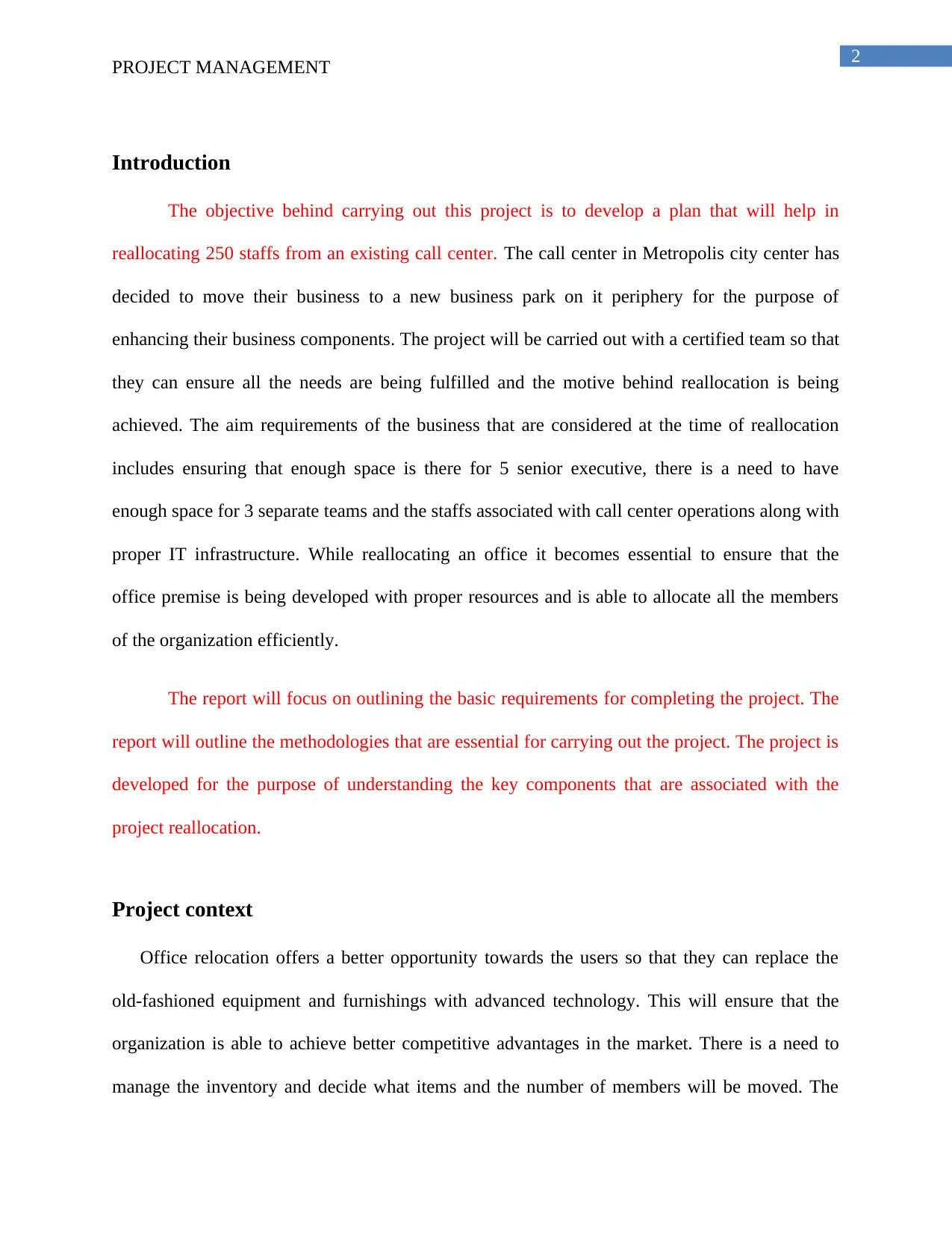
2
PROJECT MANAGEMENT
Introduction
The objective behind carrying out this project is to develop a plan that will help in
reallocating 250 staffs from an existing call center. The call center in Metropolis city center has
decided to move their business to a new business park on it periphery for the purpose of
enhancing their business components. The project will be carried out with a certified team so that
they can ensure all the needs are being fulfilled and the motive behind reallocation is being
achieved. The aim requirements of the business that are considered at the time of reallocation
includes ensuring that enough space is there for 5 senior executive, there is a need to have
enough space for 3 separate teams and the staffs associated with call center operations along with
proper IT infrastructure. While reallocating an office it becomes essential to ensure that the
office premise is being developed with proper resources and is able to allocate all the members
of the organization efficiently.
The report will focus on outlining the basic requirements for completing the project. The
report will outline the methodologies that are essential for carrying out the project. The project is
developed for the purpose of understanding the key components that are associated with the
project reallocation.
Project context
Office relocation offers a better opportunity towards the users so that they can replace the
old-fashioned equipment and furnishings with advanced technology. This will ensure that the
organization is able to achieve better competitive advantages in the market. There is a need to
manage the inventory and decide what items and the number of members will be moved. The
PROJECT MANAGEMENT
Introduction
The objective behind carrying out this project is to develop a plan that will help in
reallocating 250 staffs from an existing call center. The call center in Metropolis city center has
decided to move their business to a new business park on it periphery for the purpose of
enhancing their business components. The project will be carried out with a certified team so that
they can ensure all the needs are being fulfilled and the motive behind reallocation is being
achieved. The aim requirements of the business that are considered at the time of reallocation
includes ensuring that enough space is there for 5 senior executive, there is a need to have
enough space for 3 separate teams and the staffs associated with call center operations along with
proper IT infrastructure. While reallocating an office it becomes essential to ensure that the
office premise is being developed with proper resources and is able to allocate all the members
of the organization efficiently.
The report will focus on outlining the basic requirements for completing the project. The
report will outline the methodologies that are essential for carrying out the project. The project is
developed for the purpose of understanding the key components that are associated with the
project reallocation.
Project context
Office relocation offers a better opportunity towards the users so that they can replace the
old-fashioned equipment and furnishings with advanced technology. This will ensure that the
organization is able to achieve better competitive advantages in the market. There is a need to
manage the inventory and decide what items and the number of members will be moved. The
⊘ This is a preview!⊘
Do you want full access?
Subscribe today to unlock all pages.

Trusted by 1+ million students worldwide
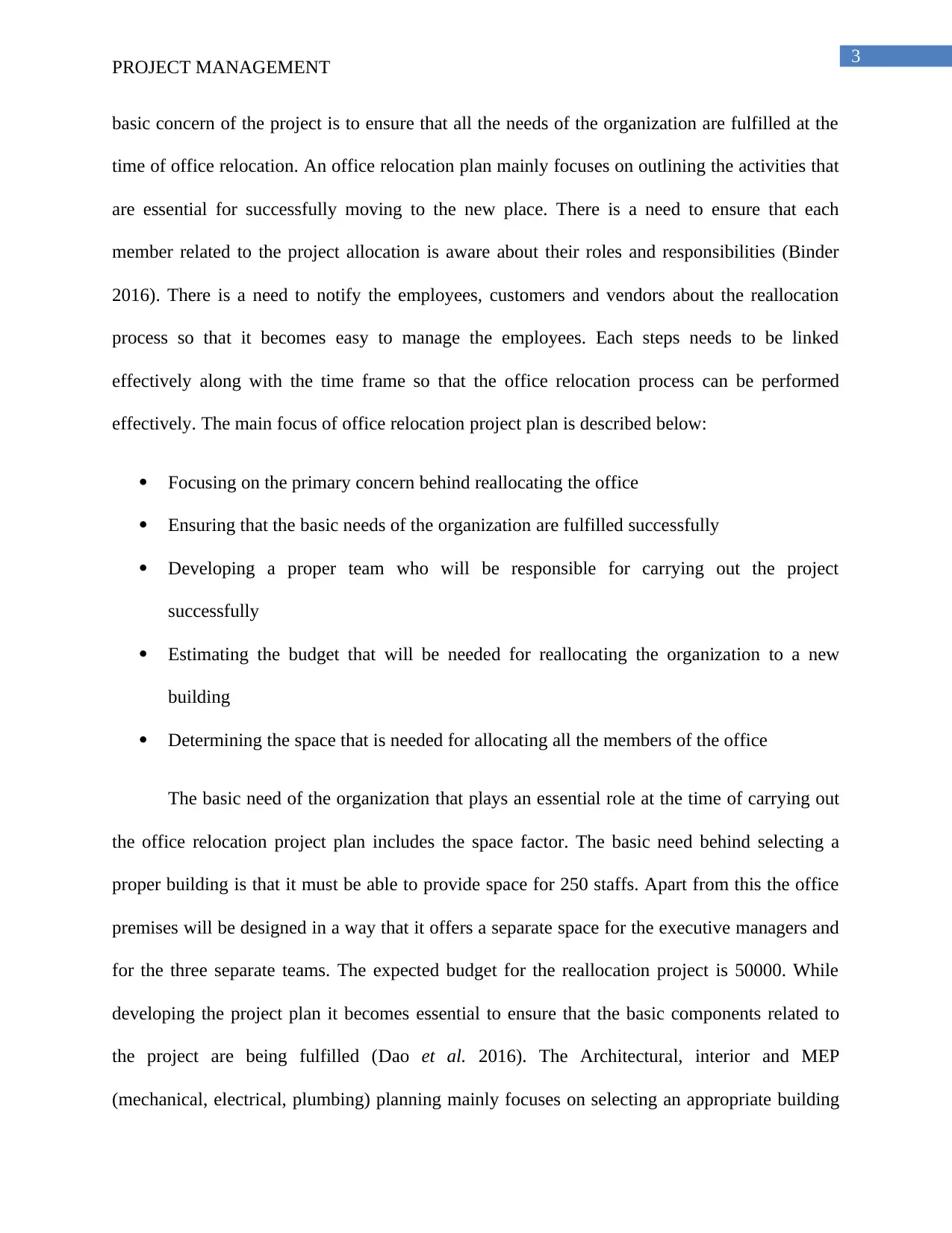
3
PROJECT MANAGEMENT
basic concern of the project is to ensure that all the needs of the organization are fulfilled at the
time of office relocation. An office relocation plan mainly focuses on outlining the activities that
are essential for successfully moving to the new place. There is a need to ensure that each
member related to the project allocation is aware about their roles and responsibilities (Binder
2016). There is a need to notify the employees, customers and vendors about the reallocation
process so that it becomes easy to manage the employees. Each steps needs to be linked
effectively along with the time frame so that the office relocation process can be performed
effectively. The main focus of office relocation project plan is described below:
Focusing on the primary concern behind reallocating the office
Ensuring that the basic needs of the organization are fulfilled successfully
Developing a proper team who will be responsible for carrying out the project
successfully
Estimating the budget that will be needed for reallocating the organization to a new
building
Determining the space that is needed for allocating all the members of the office
The basic need of the organization that plays an essential role at the time of carrying out
the office relocation project plan includes the space factor. The basic need behind selecting a
proper building is that it must be able to provide space for 250 staffs. Apart from this the office
premises will be designed in a way that it offers a separate space for the executive managers and
for the three separate teams. The expected budget for the reallocation project is 50000. While
developing the project plan it becomes essential to ensure that the basic components related to
the project are being fulfilled (Dao et al. 2016). The Architectural, interior and MEP
(mechanical, electrical, plumbing) planning mainly focuses on selecting an appropriate building
PROJECT MANAGEMENT
basic concern of the project is to ensure that all the needs of the organization are fulfilled at the
time of office relocation. An office relocation plan mainly focuses on outlining the activities that
are essential for successfully moving to the new place. There is a need to ensure that each
member related to the project allocation is aware about their roles and responsibilities (Binder
2016). There is a need to notify the employees, customers and vendors about the reallocation
process so that it becomes easy to manage the employees. Each steps needs to be linked
effectively along with the time frame so that the office relocation process can be performed
effectively. The main focus of office relocation project plan is described below:
Focusing on the primary concern behind reallocating the office
Ensuring that the basic needs of the organization are fulfilled successfully
Developing a proper team who will be responsible for carrying out the project
successfully
Estimating the budget that will be needed for reallocating the organization to a new
building
Determining the space that is needed for allocating all the members of the office
The basic need of the organization that plays an essential role at the time of carrying out
the office relocation project plan includes the space factor. The basic need behind selecting a
proper building is that it must be able to provide space for 250 staffs. Apart from this the office
premises will be designed in a way that it offers a separate space for the executive managers and
for the three separate teams. The expected budget for the reallocation project is 50000. While
developing the project plan it becomes essential to ensure that the basic components related to
the project are being fulfilled (Dao et al. 2016). The Architectural, interior and MEP
(mechanical, electrical, plumbing) planning mainly focuses on selecting an appropriate building
Paraphrase This Document
Need a fresh take? Get an instant paraphrase of this document with our AI Paraphraser
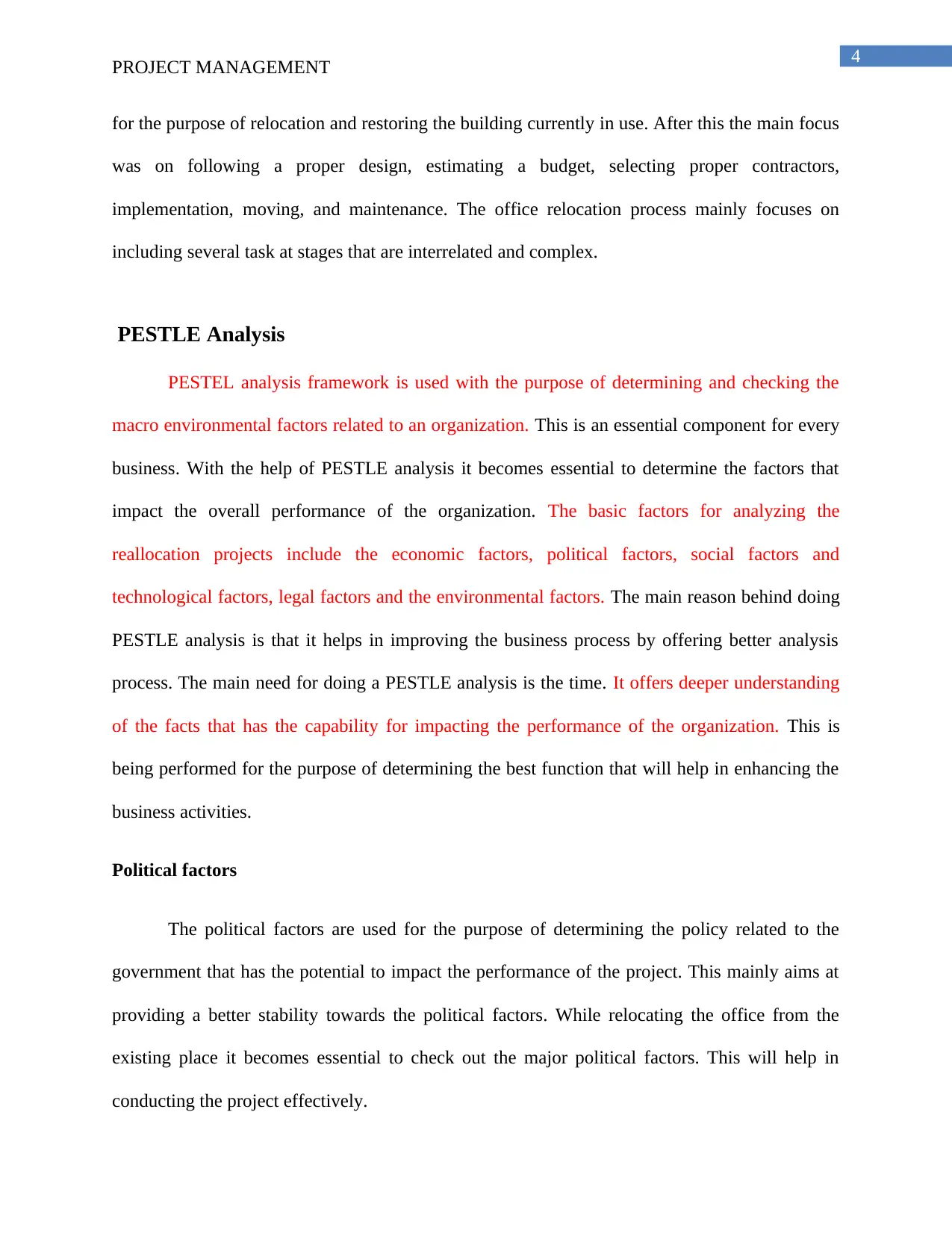
4
PROJECT MANAGEMENT
for the purpose of relocation and restoring the building currently in use. After this the main focus
was on following a proper design, estimating a budget, selecting proper contractors,
implementation, moving, and maintenance. The office relocation process mainly focuses on
including several task at stages that are interrelated and complex.
PESTLE Analysis
PESTEL analysis framework is used with the purpose of determining and checking the
macro environmental factors related to an organization. This is an essential component for every
business. With the help of PESTLE analysis it becomes essential to determine the factors that
impact the overall performance of the organization. The basic factors for analyzing the
reallocation projects include the economic factors, political factors, social factors and
technological factors, legal factors and the environmental factors. The main reason behind doing
PESTLE analysis is that it helps in improving the business process by offering better analysis
process. The main need for doing a PESTLE analysis is the time. It offers deeper understanding
of the facts that has the capability for impacting the performance of the organization. This is
being performed for the purpose of determining the best function that will help in enhancing the
business activities.
Political factors
The political factors are used for the purpose of determining the policy related to the
government that has the potential to impact the performance of the project. This mainly aims at
providing a better stability towards the political factors. While relocating the office from the
existing place it becomes essential to check out the major political factors. This will help in
conducting the project effectively.
PROJECT MANAGEMENT
for the purpose of relocation and restoring the building currently in use. After this the main focus
was on following a proper design, estimating a budget, selecting proper contractors,
implementation, moving, and maintenance. The office relocation process mainly focuses on
including several task at stages that are interrelated and complex.
PESTLE Analysis
PESTEL analysis framework is used with the purpose of determining and checking the
macro environmental factors related to an organization. This is an essential component for every
business. With the help of PESTLE analysis it becomes essential to determine the factors that
impact the overall performance of the organization. The basic factors for analyzing the
reallocation projects include the economic factors, political factors, social factors and
technological factors, legal factors and the environmental factors. The main reason behind doing
PESTLE analysis is that it helps in improving the business process by offering better analysis
process. The main need for doing a PESTLE analysis is the time. It offers deeper understanding
of the facts that has the capability for impacting the performance of the organization. This is
being performed for the purpose of determining the best function that will help in enhancing the
business activities.
Political factors
The political factors are used for the purpose of determining the policy related to the
government that has the potential to impact the performance of the project. This mainly aims at
providing a better stability towards the political factors. While relocating the office from the
existing place it becomes essential to check out the major political factors. This will help in
conducting the project effectively.
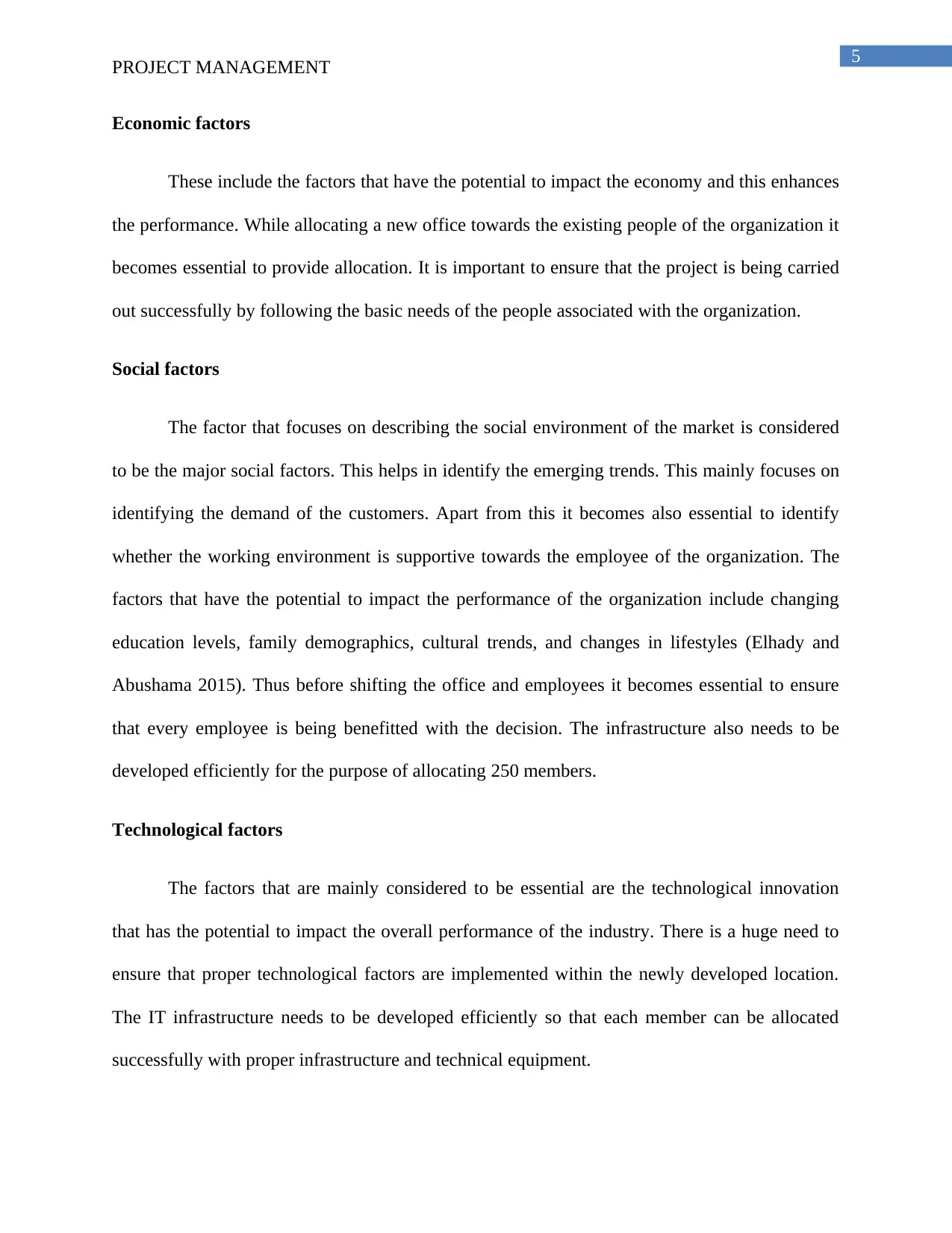
5
PROJECT MANAGEMENT
Economic factors
These include the factors that have the potential to impact the economy and this enhances
the performance. While allocating a new office towards the existing people of the organization it
becomes essential to provide allocation. It is important to ensure that the project is being carried
out successfully by following the basic needs of the people associated with the organization.
Social factors
The factor that focuses on describing the social environment of the market is considered
to be the major social factors. This helps in identify the emerging trends. This mainly focuses on
identifying the demand of the customers. Apart from this it becomes also essential to identify
whether the working environment is supportive towards the employee of the organization. The
factors that have the potential to impact the performance of the organization include changing
education levels, family demographics, cultural trends, and changes in lifestyles (Elhady and
Abushama 2015). Thus before shifting the office and employees it becomes essential to ensure
that every employee is being benefitted with the decision. The infrastructure also needs to be
developed efficiently for the purpose of allocating 250 members.
Technological factors
The factors that are mainly considered to be essential are the technological innovation
that has the potential to impact the overall performance of the industry. There is a huge need to
ensure that proper technological factors are implemented within the newly developed location.
The IT infrastructure needs to be developed efficiently so that each member can be allocated
successfully with proper infrastructure and technical equipment.
PROJECT MANAGEMENT
Economic factors
These include the factors that have the potential to impact the economy and this enhances
the performance. While allocating a new office towards the existing people of the organization it
becomes essential to provide allocation. It is important to ensure that the project is being carried
out successfully by following the basic needs of the people associated with the organization.
Social factors
The factor that focuses on describing the social environment of the market is considered
to be the major social factors. This helps in identify the emerging trends. This mainly focuses on
identifying the demand of the customers. Apart from this it becomes also essential to identify
whether the working environment is supportive towards the employee of the organization. The
factors that have the potential to impact the performance of the organization include changing
education levels, family demographics, cultural trends, and changes in lifestyles (Elhady and
Abushama 2015). Thus before shifting the office and employees it becomes essential to ensure
that every employee is being benefitted with the decision. The infrastructure also needs to be
developed efficiently for the purpose of allocating 250 members.
Technological factors
The factors that are mainly considered to be essential are the technological innovation
that has the potential to impact the overall performance of the industry. There is a huge need to
ensure that proper technological factors are implemented within the newly developed location.
The IT infrastructure needs to be developed efficiently so that each member can be allocated
successfully with proper infrastructure and technical equipment.
⊘ This is a preview!⊘
Do you want full access?
Subscribe today to unlock all pages.

Trusted by 1+ million students worldwide
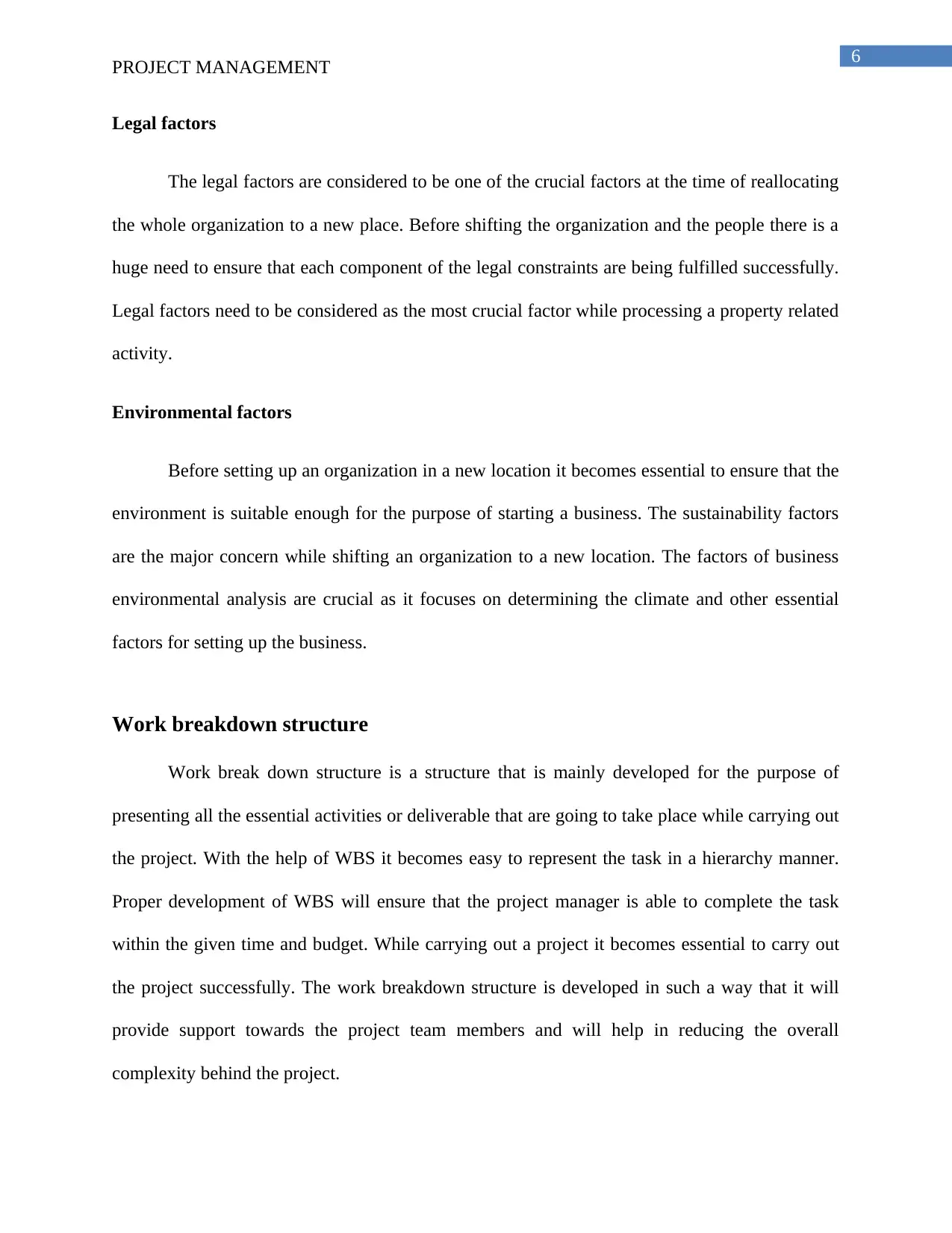
6
PROJECT MANAGEMENT
Legal factors
The legal factors are considered to be one of the crucial factors at the time of reallocating
the whole organization to a new place. Before shifting the organization and the people there is a
huge need to ensure that each component of the legal constraints are being fulfilled successfully.
Legal factors need to be considered as the most crucial factor while processing a property related
activity.
Environmental factors
Before setting up an organization in a new location it becomes essential to ensure that the
environment is suitable enough for the purpose of starting a business. The sustainability factors
are the major concern while shifting an organization to a new location. The factors of business
environmental analysis are crucial as it focuses on determining the climate and other essential
factors for setting up the business.
Work breakdown structure
Work break down structure is a structure that is mainly developed for the purpose of
presenting all the essential activities or deliverable that are going to take place while carrying out
the project. With the help of WBS it becomes easy to represent the task in a hierarchy manner.
Proper development of WBS will ensure that the project manager is able to complete the task
within the given time and budget. While carrying out a project it becomes essential to carry out
the project successfully. The work breakdown structure is developed in such a way that it will
provide support towards the project team members and will help in reducing the overall
complexity behind the project.
PROJECT MANAGEMENT
Legal factors
The legal factors are considered to be one of the crucial factors at the time of reallocating
the whole organization to a new place. Before shifting the organization and the people there is a
huge need to ensure that each component of the legal constraints are being fulfilled successfully.
Legal factors need to be considered as the most crucial factor while processing a property related
activity.
Environmental factors
Before setting up an organization in a new location it becomes essential to ensure that the
environment is suitable enough for the purpose of starting a business. The sustainability factors
are the major concern while shifting an organization to a new location. The factors of business
environmental analysis are crucial as it focuses on determining the climate and other essential
factors for setting up the business.
Work breakdown structure
Work break down structure is a structure that is mainly developed for the purpose of
presenting all the essential activities or deliverable that are going to take place while carrying out
the project. With the help of WBS it becomes easy to represent the task in a hierarchy manner.
Proper development of WBS will ensure that the project manager is able to complete the task
within the given time and budget. While carrying out a project it becomes essential to carry out
the project successfully. The work breakdown structure is developed in such a way that it will
provide support towards the project team members and will help in reducing the overall
complexity behind the project.
Paraphrase This Document
Need a fresh take? Get an instant paraphrase of this document with our AI Paraphraser
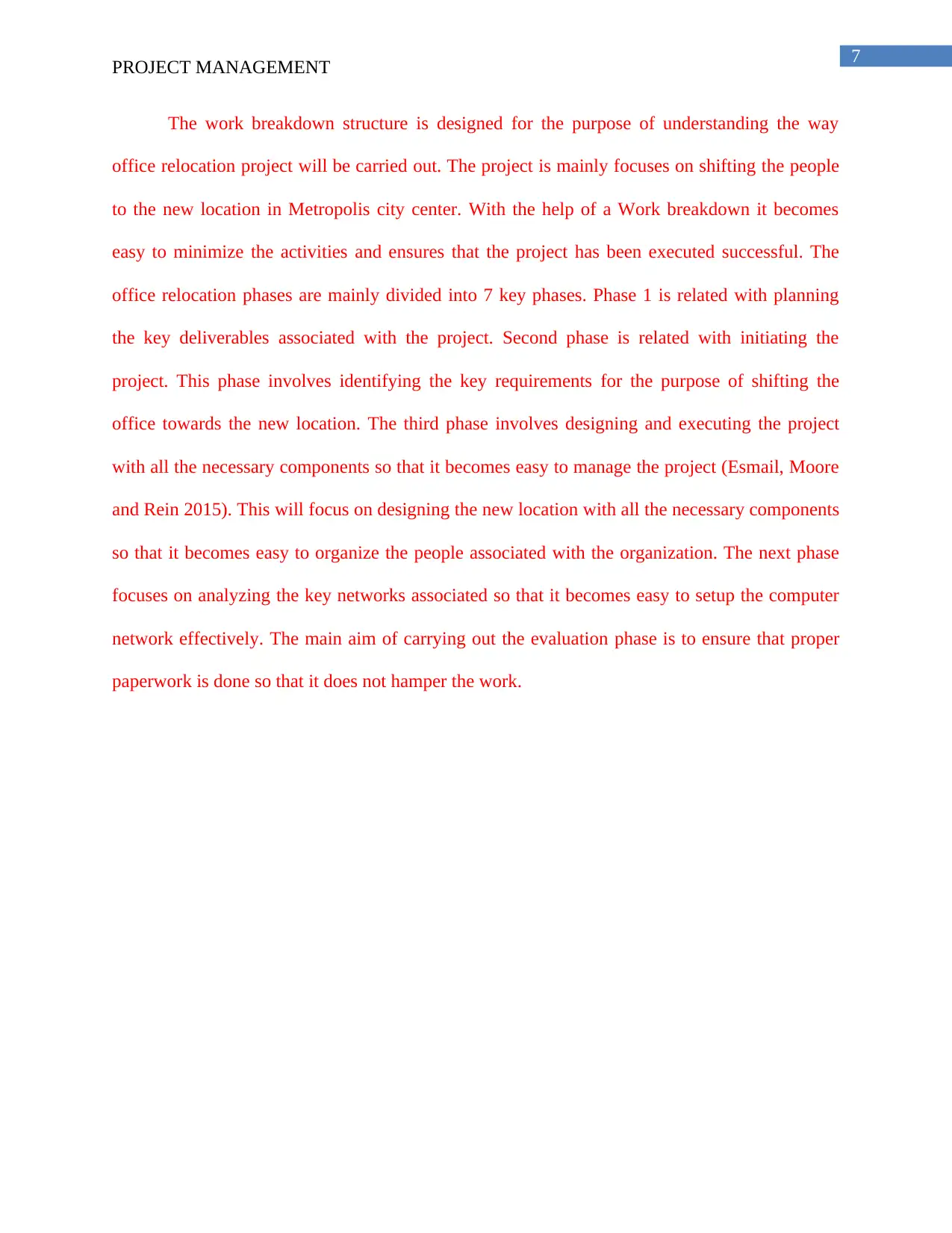
7
PROJECT MANAGEMENT
The work breakdown structure is designed for the purpose of understanding the way
office relocation project will be carried out. The project is mainly focuses on shifting the people
to the new location in Metropolis city center. With the help of a Work breakdown it becomes
easy to minimize the activities and ensures that the project has been executed successful. The
office relocation phases are mainly divided into 7 key phases. Phase 1 is related with planning
the key deliverables associated with the project. Second phase is related with initiating the
project. This phase involves identifying the key requirements for the purpose of shifting the
office towards the new location. The third phase involves designing and executing the project
with all the necessary components so that it becomes easy to manage the project (Esmail, Moore
and Rein 2015). This will focus on designing the new location with all the necessary components
so that it becomes easy to organize the people associated with the organization. The next phase
focuses on analyzing the key networks associated so that it becomes easy to setup the computer
network effectively. The main aim of carrying out the evaluation phase is to ensure that proper
paperwork is done so that it does not hamper the work.
PROJECT MANAGEMENT
The work breakdown structure is designed for the purpose of understanding the way
office relocation project will be carried out. The project is mainly focuses on shifting the people
to the new location in Metropolis city center. With the help of a Work breakdown it becomes
easy to minimize the activities and ensures that the project has been executed successful. The
office relocation phases are mainly divided into 7 key phases. Phase 1 is related with planning
the key deliverables associated with the project. Second phase is related with initiating the
project. This phase involves identifying the key requirements for the purpose of shifting the
office towards the new location. The third phase involves designing and executing the project
with all the necessary components so that it becomes easy to manage the project (Esmail, Moore
and Rein 2015). This will focus on designing the new location with all the necessary components
so that it becomes easy to organize the people associated with the organization. The next phase
focuses on analyzing the key networks associated so that it becomes easy to setup the computer
network effectively. The main aim of carrying out the evaluation phase is to ensure that proper
paperwork is done so that it does not hamper the work.
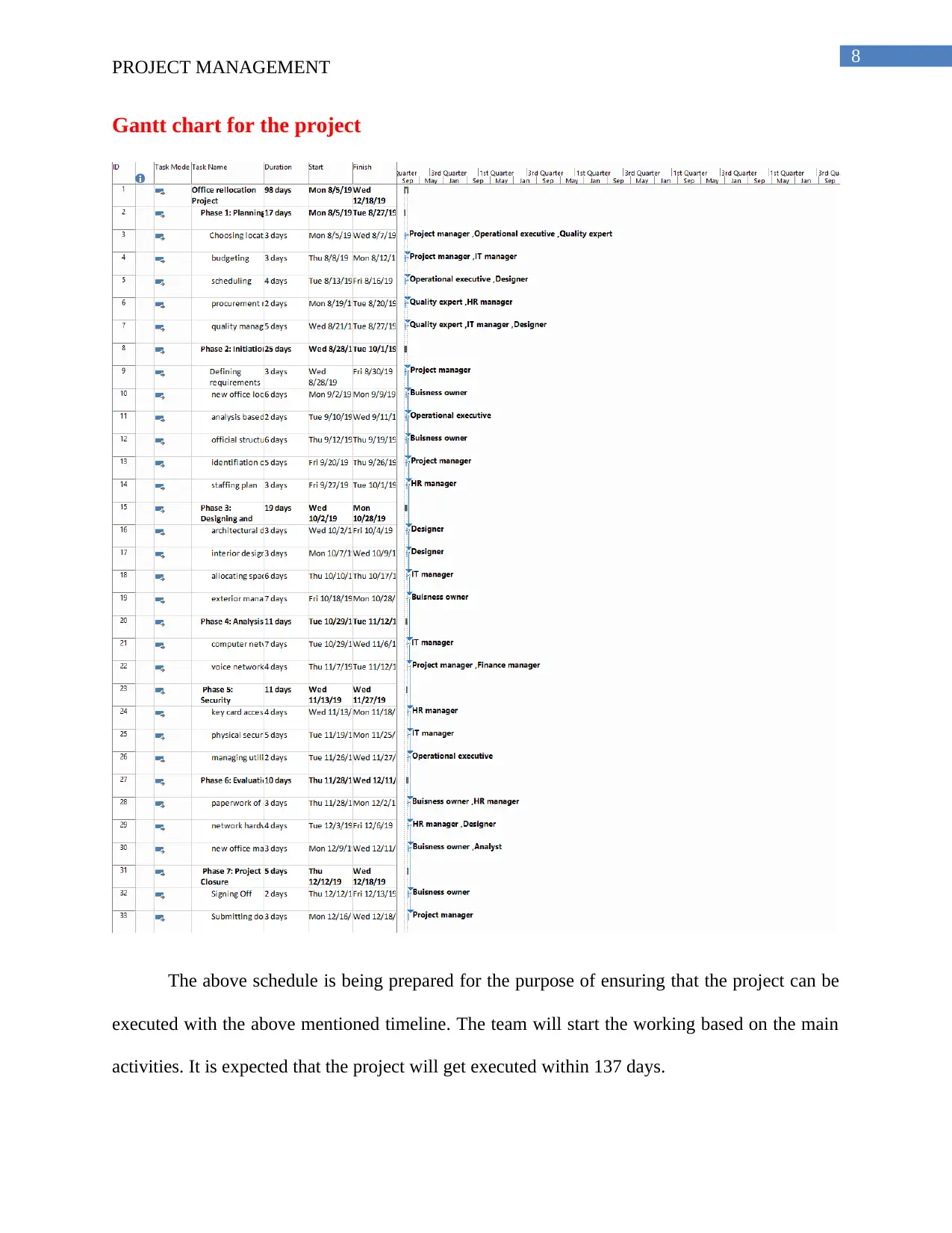
8
PROJECT MANAGEMENT
Gantt chart for the project
The above schedule is being prepared for the purpose of ensuring that the project can be
executed with the above mentioned timeline. The team will start the working based on the main
activities. It is expected that the project will get executed within 137 days.
PROJECT MANAGEMENT
Gantt chart for the project
The above schedule is being prepared for the purpose of ensuring that the project can be
executed with the above mentioned timeline. The team will start the working based on the main
activities. It is expected that the project will get executed within 137 days.
⊘ This is a preview!⊘
Do you want full access?
Subscribe today to unlock all pages.

Trusted by 1+ million students worldwide
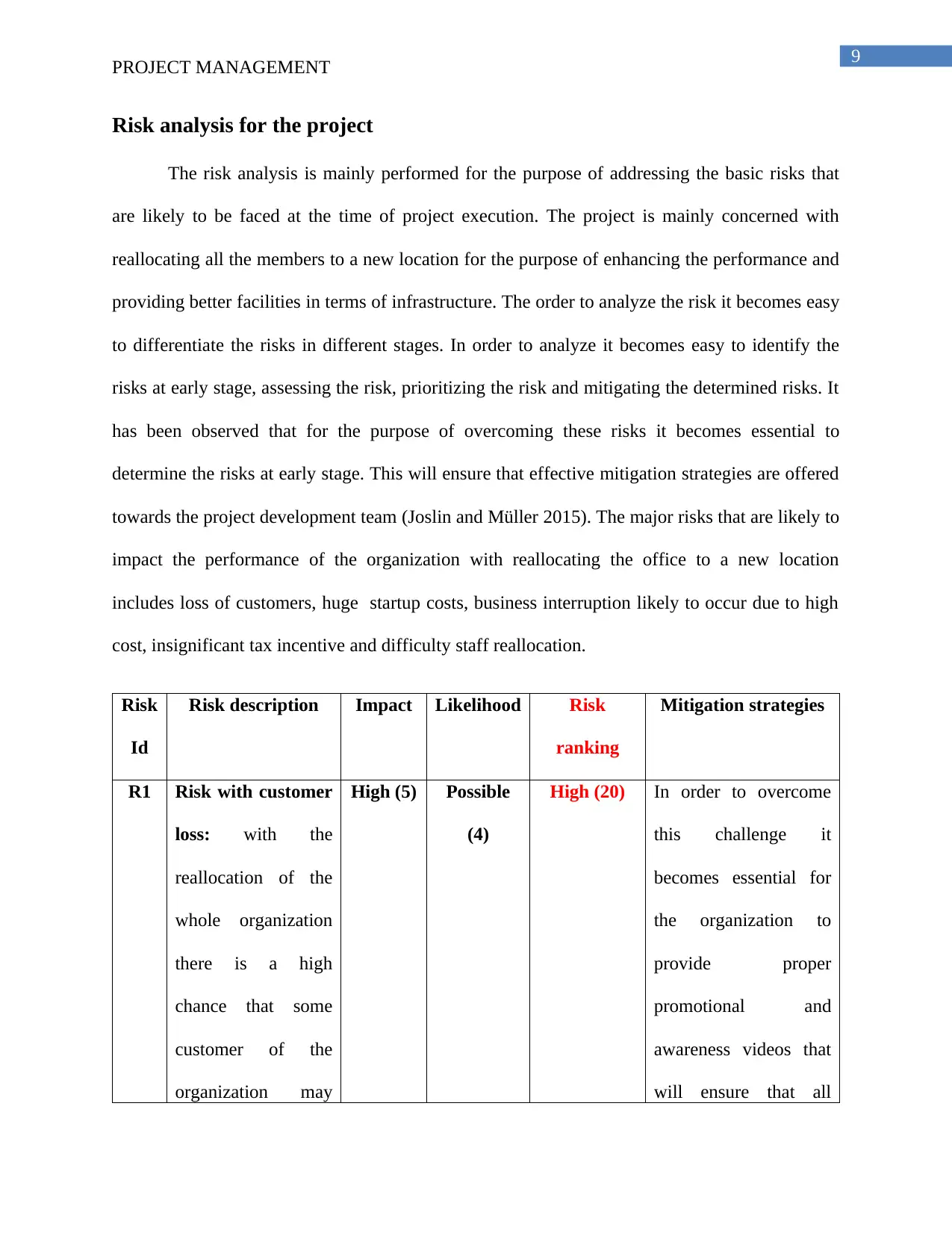
9
PROJECT MANAGEMENT
Risk analysis for the project
The risk analysis is mainly performed for the purpose of addressing the basic risks that
are likely to be faced at the time of project execution. The project is mainly concerned with
reallocating all the members to a new location for the purpose of enhancing the performance and
providing better facilities in terms of infrastructure. The order to analyze the risk it becomes easy
to differentiate the risks in different stages. In order to analyze it becomes easy to identify the
risks at early stage, assessing the risk, prioritizing the risk and mitigating the determined risks. It
has been observed that for the purpose of overcoming these risks it becomes essential to
determine the risks at early stage. This will ensure that effective mitigation strategies are offered
towards the project development team (Joslin and Müller 2015). The major risks that are likely to
impact the performance of the organization with reallocating the office to a new location
includes loss of customers, huge startup costs, business interruption likely to occur due to high
cost, insignificant tax incentive and difficulty staff reallocation.
Risk
Id
Risk description Impact Likelihood Risk
ranking
Mitigation strategies
R1 Risk with customer
loss: with the
reallocation of the
whole organization
there is a high
chance that some
customer of the
organization may
High (5) Possible
(4)
High (20) In order to overcome
this challenge it
becomes essential for
the organization to
provide proper
promotional and
awareness videos that
will ensure that all
PROJECT MANAGEMENT
Risk analysis for the project
The risk analysis is mainly performed for the purpose of addressing the basic risks that
are likely to be faced at the time of project execution. The project is mainly concerned with
reallocating all the members to a new location for the purpose of enhancing the performance and
providing better facilities in terms of infrastructure. The order to analyze the risk it becomes easy
to differentiate the risks in different stages. In order to analyze it becomes easy to identify the
risks at early stage, assessing the risk, prioritizing the risk and mitigating the determined risks. It
has been observed that for the purpose of overcoming these risks it becomes essential to
determine the risks at early stage. This will ensure that effective mitigation strategies are offered
towards the project development team (Joslin and Müller 2015). The major risks that are likely to
impact the performance of the organization with reallocating the office to a new location
includes loss of customers, huge startup costs, business interruption likely to occur due to high
cost, insignificant tax incentive and difficulty staff reallocation.
Risk
Id
Risk description Impact Likelihood Risk
ranking
Mitigation strategies
R1 Risk with customer
loss: with the
reallocation of the
whole organization
there is a high
chance that some
customer of the
organization may
High (5) Possible
(4)
High (20) In order to overcome
this challenge it
becomes essential for
the organization to
provide proper
promotional and
awareness videos that
will ensure that all
Paraphrase This Document
Need a fresh take? Get an instant paraphrase of this document with our AI Paraphraser
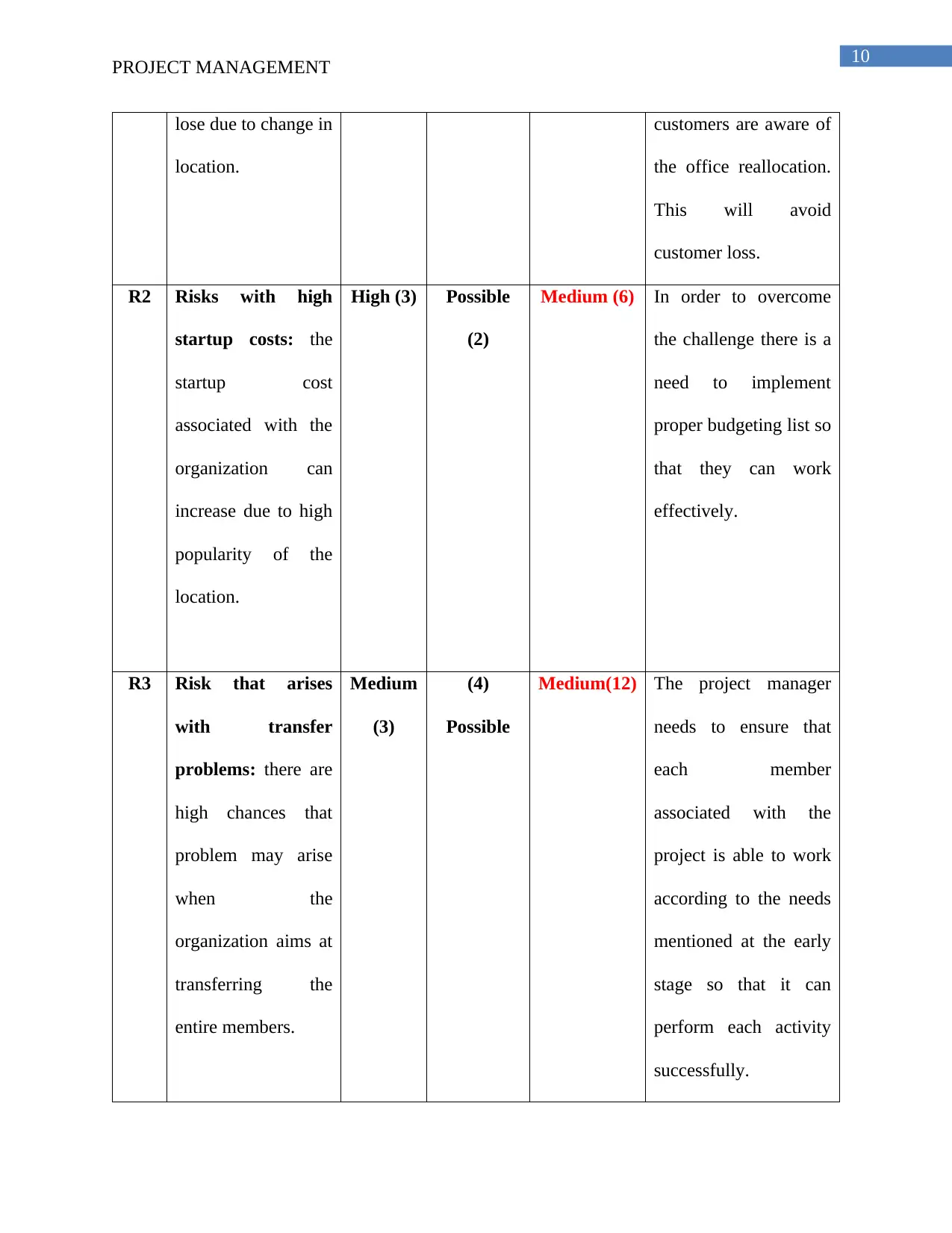
10
PROJECT MANAGEMENT
lose due to change in
location.
customers are aware of
the office reallocation.
This will avoid
customer loss.
R2 Risks with high
startup costs: the
startup cost
associated with the
organization can
increase due to high
popularity of the
location.
High (3) Possible
(2)
Medium (6) In order to overcome
the challenge there is a
need to implement
proper budgeting list so
that they can work
effectively.
R3 Risk that arises
with transfer
problems: there are
high chances that
problem may arise
when the
organization aims at
transferring the
entire members.
Medium
(3)
(4)
Possible
Medium(12) The project manager
needs to ensure that
each member
associated with the
project is able to work
according to the needs
mentioned at the early
stage so that it can
perform each activity
successfully.
PROJECT MANAGEMENT
lose due to change in
location.
customers are aware of
the office reallocation.
This will avoid
customer loss.
R2 Risks with high
startup costs: the
startup cost
associated with the
organization can
increase due to high
popularity of the
location.
High (3) Possible
(2)
Medium (6) In order to overcome
the challenge there is a
need to implement
proper budgeting list so
that they can work
effectively.
R3 Risk that arises
with transfer
problems: there are
high chances that
problem may arise
when the
organization aims at
transferring the
entire members.
Medium
(3)
(4)
Possible
Medium(12) The project manager
needs to ensure that
each member
associated with the
project is able to work
according to the needs
mentioned at the early
stage so that it can
perform each activity
successfully.
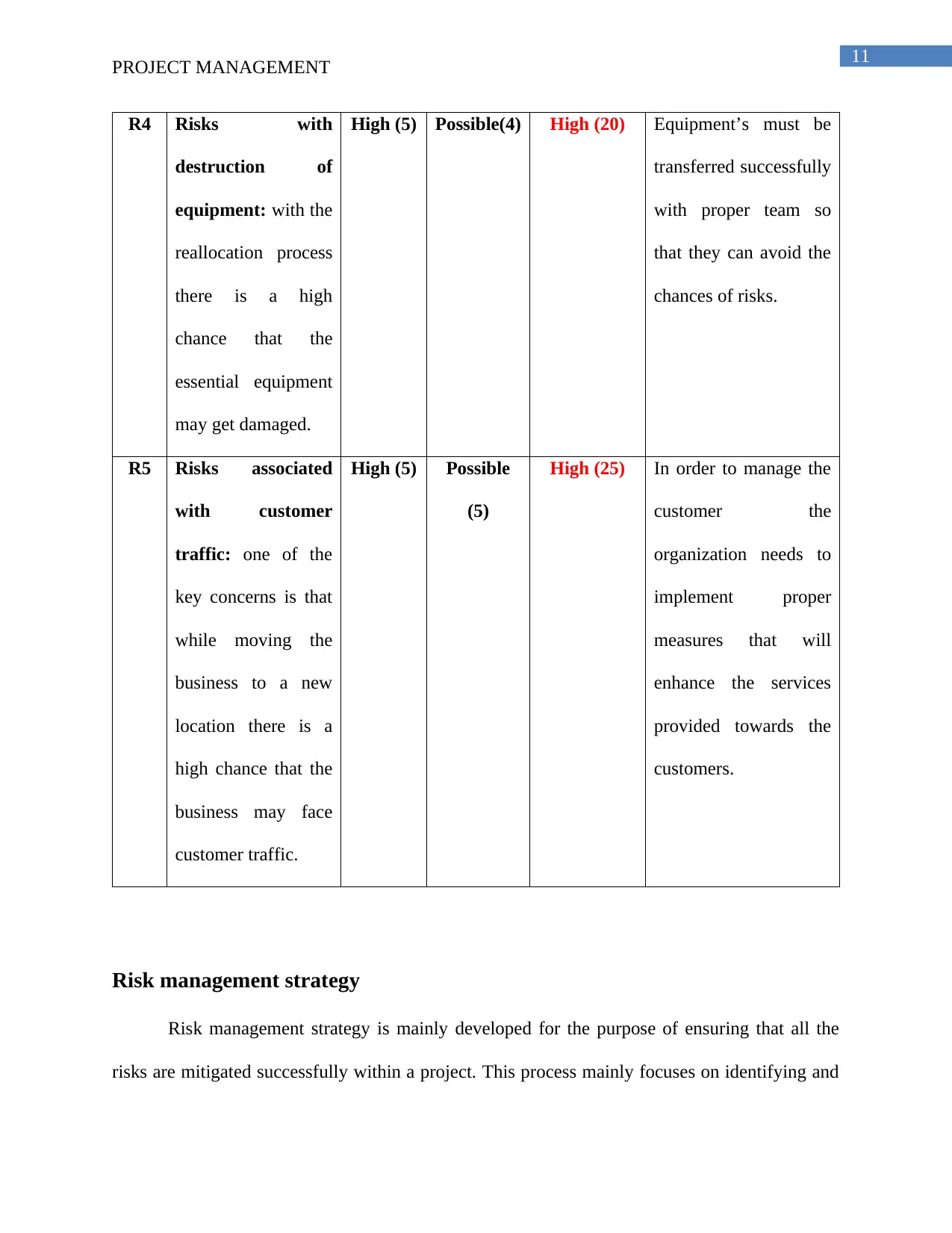
11
PROJECT MANAGEMENT
R4 Risks with
destruction of
equipment: with the
reallocation process
there is a high
chance that the
essential equipment
may get damaged.
High (5) Possible(4) High (20) Equipment’s must be
transferred successfully
with proper team so
that they can avoid the
chances of risks.
R5 Risks associated
with customer
traffic: one of the
key concerns is that
while moving the
business to a new
location there is a
high chance that the
business may face
customer traffic.
High (5) Possible
(5)
High (25) In order to manage the
customer the
organization needs to
implement proper
measures that will
enhance the services
provided towards the
customers.
Risk management strategy
Risk management strategy is mainly developed for the purpose of ensuring that all the
risks are mitigated successfully within a project. This process mainly focuses on identifying and
PROJECT MANAGEMENT
R4 Risks with
destruction of
equipment: with the
reallocation process
there is a high
chance that the
essential equipment
may get damaged.
High (5) Possible(4) High (20) Equipment’s must be
transferred successfully
with proper team so
that they can avoid the
chances of risks.
R5 Risks associated
with customer
traffic: one of the
key concerns is that
while moving the
business to a new
location there is a
high chance that the
business may face
customer traffic.
High (5) Possible
(5)
High (25) In order to manage the
customer the
organization needs to
implement proper
measures that will
enhance the services
provided towards the
customers.
Risk management strategy
Risk management strategy is mainly developed for the purpose of ensuring that all the
risks are mitigated successfully within a project. This process mainly focuses on identifying and
⊘ This is a preview!⊘
Do you want full access?
Subscribe today to unlock all pages.

Trusted by 1+ million students worldwide
1 out of 25
Related Documents
Your All-in-One AI-Powered Toolkit for Academic Success.
+13062052269
info@desklib.com
Available 24*7 on WhatsApp / Email
![[object Object]](/_next/static/media/star-bottom.7253800d.svg)
Unlock your academic potential
Copyright © 2020–2025 A2Z Services. All Rights Reserved. Developed and managed by ZUCOL.





